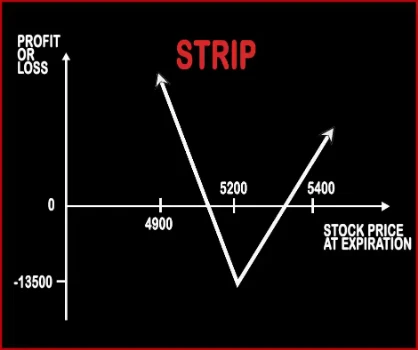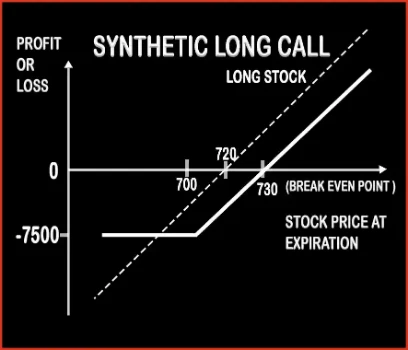Compare Strategies
| STRIP | SYNTHETIC LONG CALL | |
|---|---|---|

|

|
|
| About Strategy |
Strip Option StrategyStrip Strategy is the opposite of Strap Strategy. When a trader is bearish on the market and bullish on volatility then he will implement this strategy by buying two ATM Put Options & one ATM Call Option, of the same strike price, expiry date & underlying asset. If the prices move downwards then this strategy will make more profits compared to short straddle because of the |
Synthetic Long Call Option StrategyA trader is bullish in nature for short term, but also fearful about the downside risk associated with it. Here, a trader wants to hold an underlying asset either in physical form like in case of commodities or demat (electronic) form in case of stocks. But he is always exposed to downside risk and in order to mitigate his losses, .. |
STRIP Vs SYNTHETIC LONG CALL - Details
| STRIP | SYNTHETIC LONG CALL | |
|---|---|---|
| Market View | Neutral | Bullish |
| Type (CE/PE) | CE (Call Option) + PE (Put Option) | CE (Call Option) |
| Number Of Positions | 3 | 2 |
| Strategy Level | Beginners | Beginners |
| Reward Profile | Unlimited | When Price of Underlying > Purchase Price of Underlying + Premium Paid |
| Risk Profile | Limited | Limited (Maximum loss happens when the price of instrument move above from the strike price of put) |
| Breakeven Point | Upper Breakeven Point = Strike Price of Calls/Puts + Net Premium Paid, Lower Breakeven Point = Strike Price of Calls/Puts - (Net Premium Paid/2) | Underlying Price + Put Premium |
STRIP Vs SYNTHETIC LONG CALL - When & How to use ?
| STRIP | SYNTHETIC LONG CALL | |
|---|---|---|
| Market View | Neutral | Bullish |
| When to use? | When a trader is bearish on the market and bullish on volatility then he will implement this strategy. | A trader is bullish in nature for short term, but also fearful about the downside risk associated with it. |
| Action | Buy 1 ATM Call, Buy 2 ATM Puts | Buy 1 ATM Put or OTM Put |
| Breakeven Point | Upper Breakeven Point = Strike Price of Calls/Puts + Net Premium Paid, Lower Breakeven Point = Strike Price of Calls/Puts - (Net Premium Paid/2) | Underlying Price + Put Premium |
STRIP Vs SYNTHETIC LONG CALL - Risk & Reward
| STRIP | SYNTHETIC LONG CALL | |
|---|---|---|
| Maximum Profit Scenario | Price of Underlying - Strike Price of Calls - Net Premium Paid OR 2 x (Strike Price of Puts - Price of Underlying) - Net Premium Paid | Current Price - Purchase Price - Premium Paid |
| Maximum Loss Scenario | Net Premium Paid + Commissions Paid | Premium Paid |
| Risk | Limited | Limited |
| Reward | Unlimited | Unlimited |
STRIP Vs SYNTHETIC LONG CALL - Strategy Pros & Cons
| STRIP | SYNTHETIC LONG CALL | |
|---|---|---|
| Similar Strategies | Strap, Short Put Ladder | Protective Put, Long Call |
| Disadvantage | Expensive., The share price must change significantly to generate profit., High Bid/Offer spread can have a negative influence on the position. | •Chances of loss if the underlying goes down. •Incur losses if option is exercised. |
| Advantages | Profit is generated when the share price changes in any direction., Limited loss., The profit is potentially unlimited when share prices are moving. | •Limited risk, unlimited profit. •Protection to your long-term holdings. • Limited loss to the to the premium paid for Put option. |